Abstract
Friedreich ataxia (FA) is associated with the expansion of a GAA trinucleotide repeat in the first intron of the X25 gene. We found both alleles expanded in 67 FA patients from 48 Italian families. Five patients from three families were compound heterozygotes with expansion on one allele and an isoleucine-->phenylalanine change at position 154 on the other one. We found neither expansions nor point mutations in three patients. The length of FA alleles ranged from 201 to 1,186 repeat units, with no overlap with the normal range, and showed a negatively skewed distribution with a peak between 800 and 1,000 repeats. The FA repeat showed meiotic instability with a median variation of 150 repeats. The lengths of both larger and smaller alleles in each patient inversely correlated with age at onset of the disorder. Smaller alleles showed the best correlation, accounting for approximately 50% of the variation of age at onset. Mean allele length was significantly higher in patients with diabetes and in those with cardiomyopathy.
Full text
PDF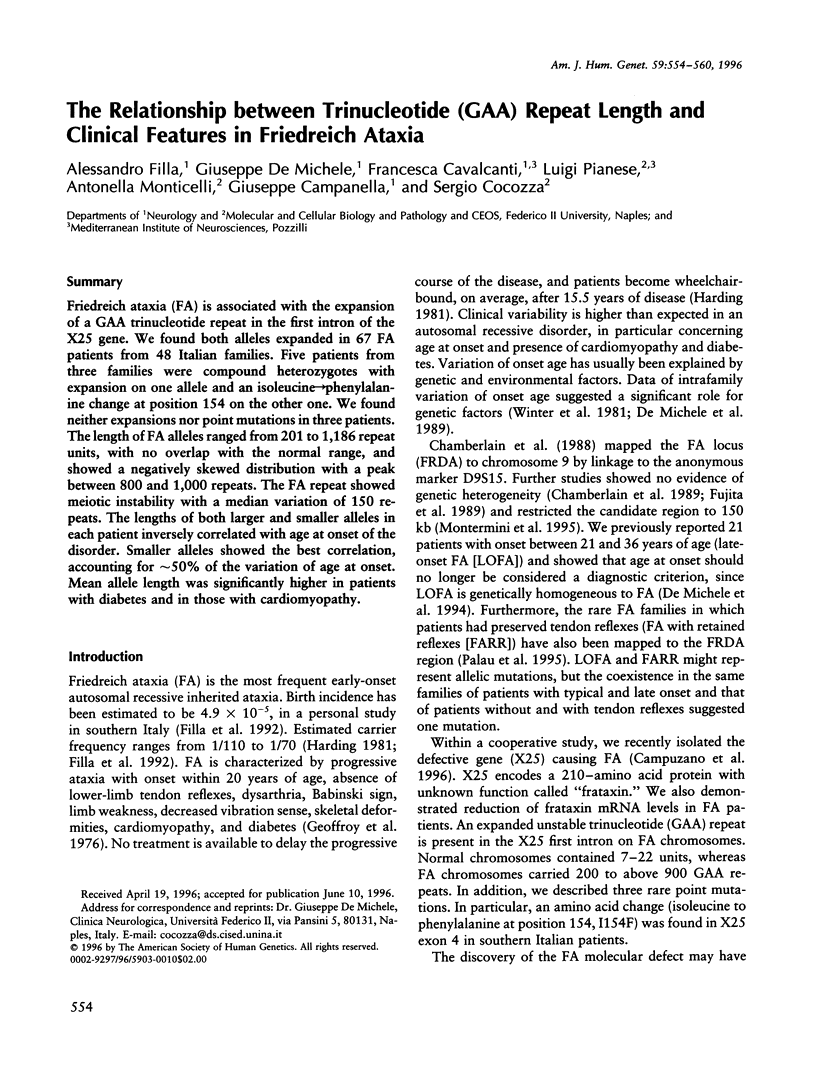
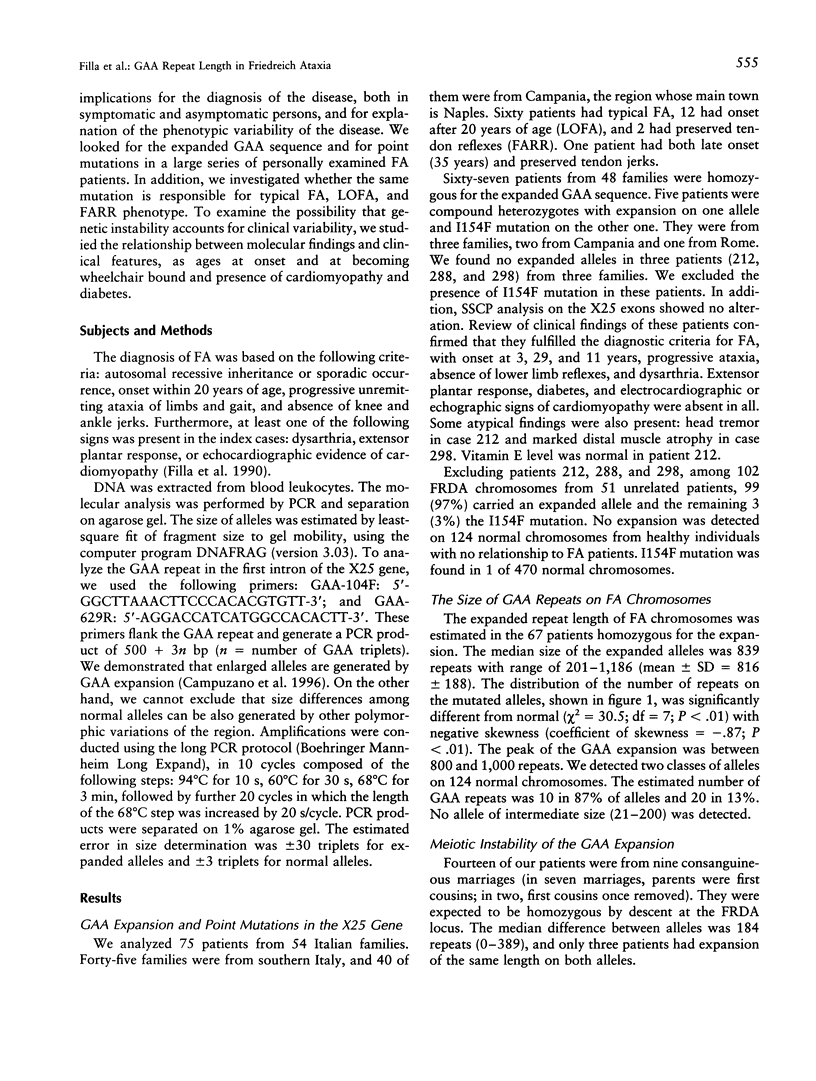
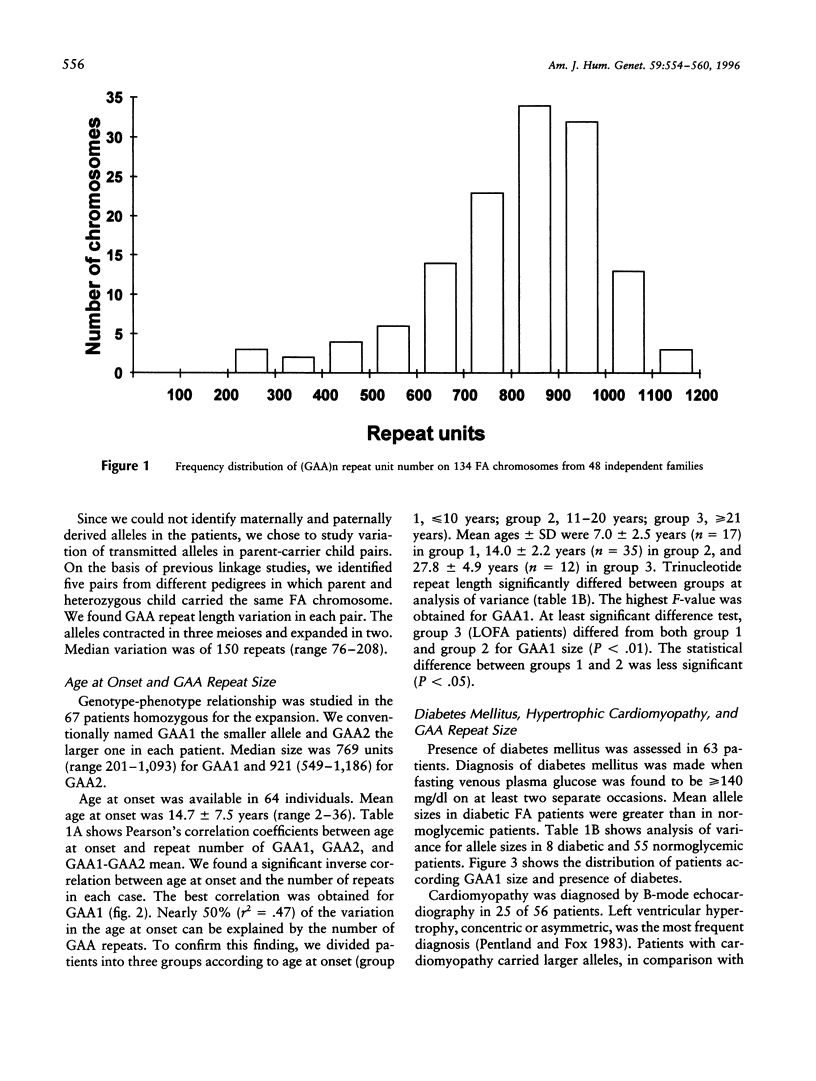
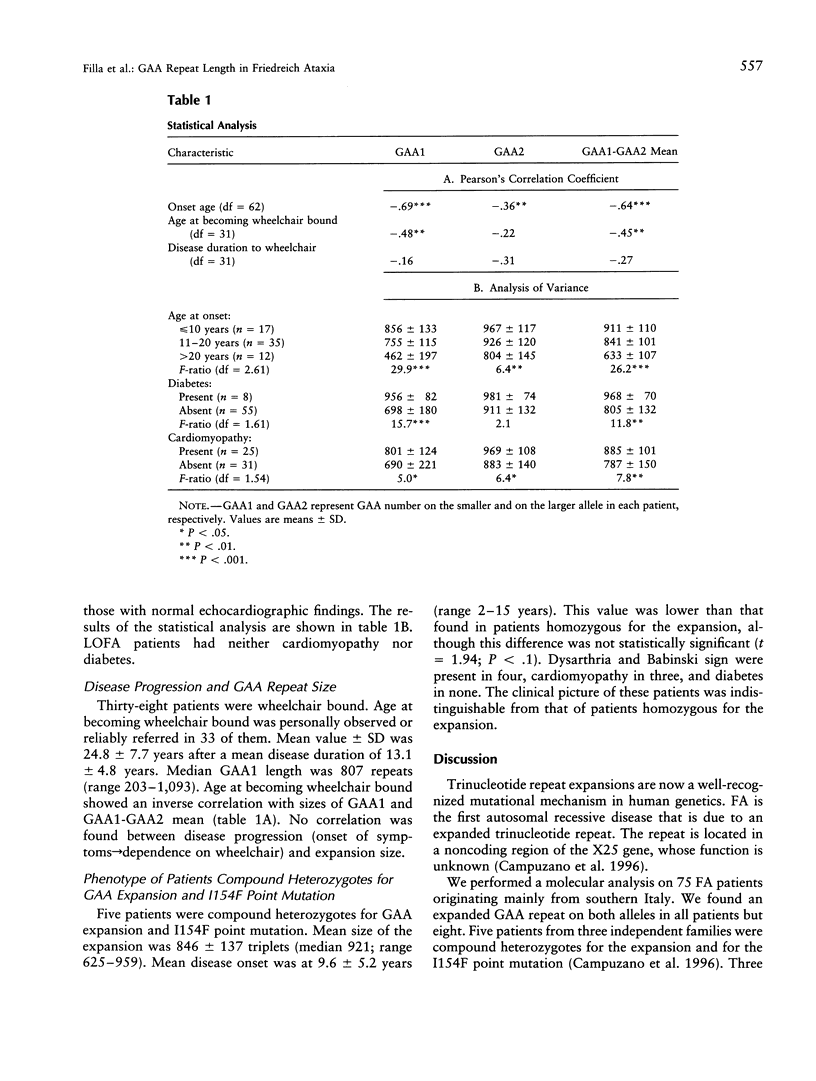
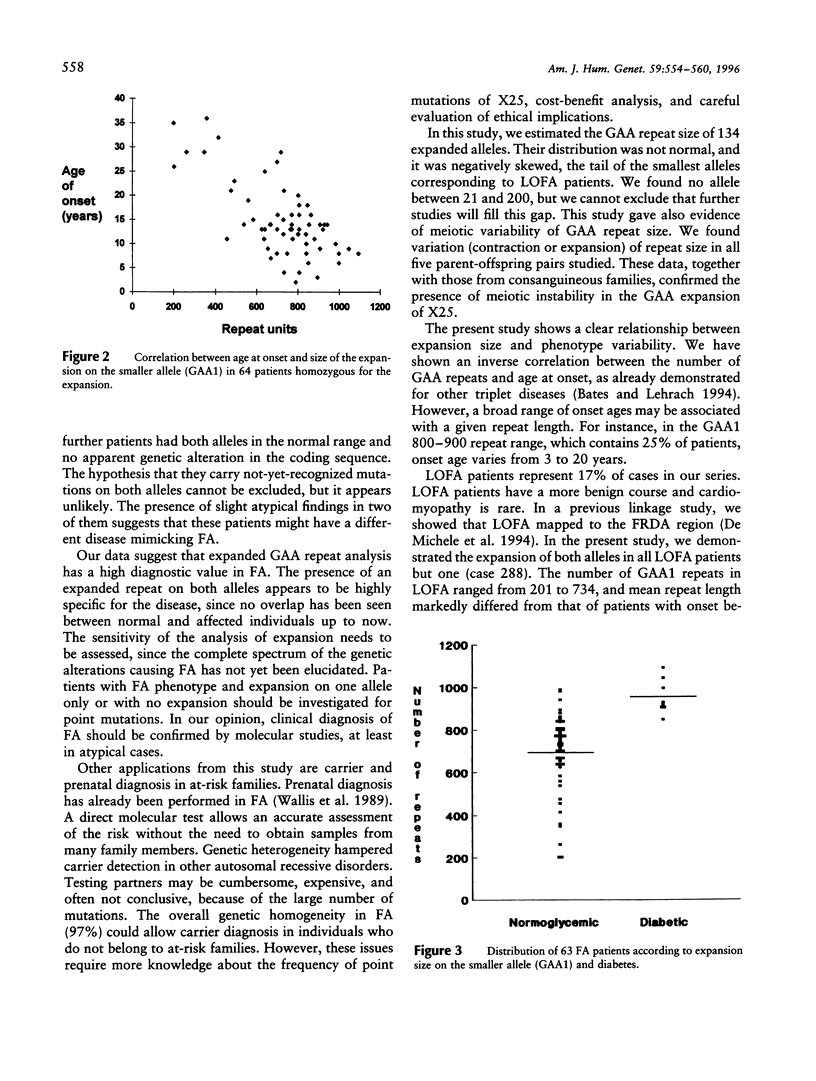
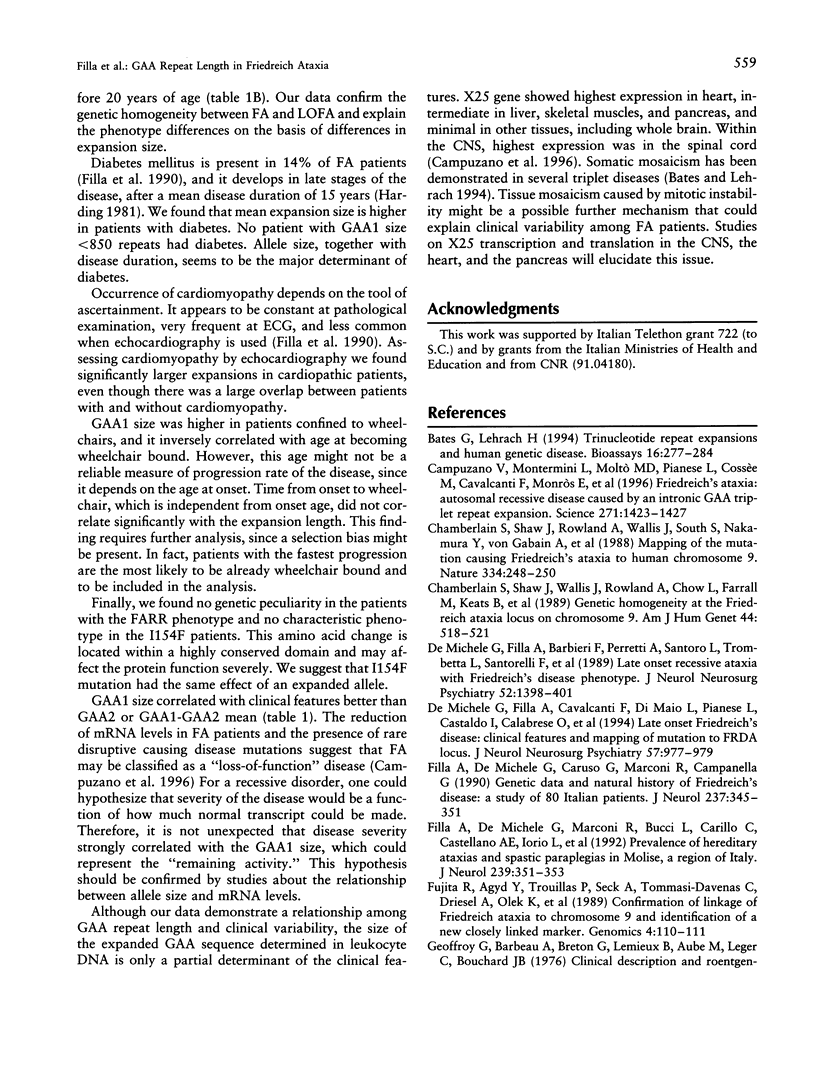

Selected References
These references are in PubMed. This may not be the complete list of references from this article.
- Bates G., Lehrach H. Trinucleotide repeat expansions and human genetic disease. Bioessays. 1994 Apr;16(4):277–284. doi: 10.1002/bies.950160411. [DOI] [PubMed] [Google Scholar]
- Campuzano V., Montermini L., Moltò M. D., Pianese L., Cossée M., Cavalcanti F., Monros E., Rodius F., Duclos F., Monticelli A. Friedreich's ataxia: autosomal recessive disease caused by an intronic GAA triplet repeat expansion. Science. 1996 Mar 8;271(5254):1423–1427. doi: 10.1126/science.271.5254.1423. [DOI] [PubMed] [Google Scholar]
- Chamberlain S., Shaw J., Rowland A., Wallis J., South S., Nakamura Y., von Gabain A., Farrall M., Williamson R. Mapping of mutation causing Friedreich's ataxia to human chromosome 9. Nature. 1988 Jul 21;334(6179):248–250. doi: 10.1038/334248a0. [DOI] [PubMed] [Google Scholar]
- Chamberlain S., Shaw J., Wallis J., Rowland A., Chow L., Farrall M., Keats B., Richter A., Roy M., Melancon S. Genetic homogeneity at the Friedreich ataxia locus on chromosome 9. Am J Hum Genet. 1989 Apr;44(4):518–521. [PMC free article] [PubMed] [Google Scholar]
- De Michele G., Filla A., Barbieri F., Perretti A., Santoro L., Trombetta L., Santorelli F., Campanella G. Late onset recessive ataxia with Friedreich's disease phenotype. J Neurol Neurosurg Psychiatry. 1989 Dec;52(12):1398–1401. doi: 10.1136/jnnp.52.12.1398. [DOI] [PMC free article] [PubMed] [Google Scholar]
- De Michele G., Filla A., Cavalcanti F., Di Maio L., Pianese L., Castaldo I., Calabrese O., Monticelli A., Varrone S., Campanella G. Late onset Friedreich's disease: clinical features and mapping of mutation to the FRDA locus. J Neurol Neurosurg Psychiatry. 1994 Aug;57(8):977–979. doi: 10.1136/jnnp.57.8.977. [DOI] [PMC free article] [PubMed] [Google Scholar]
- Filla A., De Michele G., Marconi R., Bucci L., Carillo C., Castellano A. E., Iorio L., Kniahynicki C., Rossi F., Campanella G. Prevalence of hereditary ataxias and spastic paraplegias in Molise, a region of Italy. J Neurol. 1992 Jul;239(6):351–353. doi: 10.1007/BF00867594. [DOI] [PubMed] [Google Scholar]
- Filla A., DeMichele G., Caruso G., Marconi R., Campanella G. Genetic data and natural history of Friedreich's disease: a study of 80 Italian patients. J Neurol. 1990 Oct;237(6):345–351. doi: 10.1007/BF00315657. [DOI] [PubMed] [Google Scholar]
- Fujita R., Agid Y., Trouillas P., Seck A., Tommasi-Davenas C., Driesel A. J., Olek K., Grzeschik K. H., Nakamura Y., Mandel J. L. Confirmation of linkage of Friedreich ataxia to chromosome 9 and identification of a new closely linked marker. Genomics. 1989 Jan;4(1):110–111. doi: 10.1016/0888-7543(89)90323-6. [DOI] [PubMed] [Google Scholar]
- Harding A. E. Friedreich's ataxia: a clinical and genetic study of 90 families with an analysis of early diagnostic criteria and intrafamilial clustering of clinical features. Brain. 1981 Sep;104(3):589–620. doi: 10.1093/brain/104.3.589. [DOI] [PubMed] [Google Scholar]
- Montermini L., Rodius F., Pianese L., Moltò M. D., Cossée M., Campuzano V., Cavalcanti F., Monticelli A., Palau F., Gyapay G. The Friedreich ataxia critical region spans a 150-kb interval on chromosome 9q13. Am J Hum Genet. 1995 Nov;57(5):1061–1067. [PMC free article] [PubMed] [Google Scholar]
- Palau F., De Michele G., Vilchez J. J., Pandolfo M., Monrós E., Cocozza S., Smeyers P., Lopez-Arlandis J., Campanella G., Di Donato S. Early-onset ataxia with cardiomyopathy and retained tendon reflexes maps to the Friedreich's ataxia locus on chromosome 9q. Ann Neurol. 1995 Mar;37(3):359–362. doi: 10.1002/ana.410370312. [DOI] [PubMed] [Google Scholar]
- Pentland B., Fox K. A. The heart in Friedreich's ataxia. J Neurol Neurosurg Psychiatry. 1983 Dec;46(12):1138–1142. doi: 10.1136/jnnp.46.12.1138. [DOI] [PMC free article] [PubMed] [Google Scholar]
- Wallis J., Shaw J., Wilkes D., Farrall M., Williamson R., Chamberlain S., Skare J. C., Milunsky A. Prenatal diagnosis of Friedreich ataxia. Am J Med Genet. 1989 Nov;34(3):458–461. doi: 10.1002/ajmg.1320340327. [DOI] [PubMed] [Google Scholar]
- Winter R. M., Harding A. E., Baraitser M., Bravery M. B. Intrafamilial correlation in Friedreich's ataxia. Clin Genet. 1981 Dec;20(6):419–427. doi: 10.1111/j.1399-0004.1981.tb01052.x. [DOI] [PubMed] [Google Scholar]


